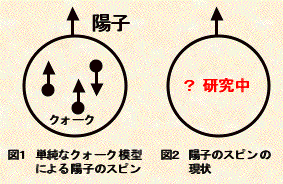Structure function and parton distribution of nucleons and nuclei
 It is known that a nucleon consists of elementary particles, that is, quarks and gluons. Understanding nucleons and their composites, nuclei, from the physical properties of quarks and gluons is important for the following purposes: (1) to discover phenomena beyond the present standard model, (2) to detect quark-gluon plasma states in heavy ion reactions, and (3)to clarify the mechanism of the basic structure of nucleons and nuclei at high energy region. Although nuclei have been formerly described by nucleons and mesons, it is important to describe them by their elementary components, namely quarks and gluons, and to develop `the quark nuclear physics', in which we try to understand the nuclear structure from a new fundamental point of view. In our group we investigate the quark-gluon distribution function, in particular. Please visit the following cite for the details of our investigation. It is known that a nucleon consists of elementary particles, that is, quarks and gluons. Understanding nucleons and their composites, nuclei, from the physical properties of quarks and gluons is important for the following purposes: (1) to discover phenomena beyond the present standard model, (2) to detect quark-gluon plasma states in heavy ion reactions, and (3)to clarify the mechanism of the basic structure of nucleons and nuclei at high energy region. Although nuclei have been formerly described by nucleons and mesons, it is important to describe them by their elementary components, namely quarks and gluons, and to develop `the quark nuclear physics', in which we try to understand the nuclear structure from a new fundamental point of view. In our group we investigate the quark-gluon distribution function, in particular. Please visit the following cite for the details of our investigation.
Let us here consider the spin structure of protons as an example of our investigation. The spin of protons is one half as every student majoring physics would know. However, it is not well-known how the spin is made up from the spin of quarks and gluons. It is a regrettable situation that we do not even know the origin of fundamental physical quantities such as the proton spin when we try to establish the theory of hadron structure. As is shown in Fig. 1, proton consists of three quarks in the simple quark model. Since a quark is an elementary particle with spin one half, the simplest idea would be to consider that the spin of two quarks cancels each other and the remaining quark carries the proton spin. However, such a reasonable expectation has been disproved by polarized lepton-nucleon scattering experiments. According to these experiments, quarks carry only a small portion of the proton spin. They are clearly inconsistent with the prediction based on the quark model. By analyzing the data from polarized lepton-nucleon scattering experiments made all over the world, we have indicated the strong possibility that it is gluons rather than quarks that carry almost all the proton spin. We have publicized the acquired polarized quark-gluon distribution function so that other researchers can make use of it (http://spin.riken.bnl.gov/aac/). Since the error in the gluon polarization is still very large, we have not yet been able to pin down the origin of the proton spin as indicated in Fig. 2, and the problem is left for future research projects. It is expected that this subject develops in the next ten years, especially in the next two years.
Phase structure of QCD
Although water is liquid at the room temperature and the atmospheric pressure, a phase transition occurs when the temperature or the pressure is changed. It becomes gas (vapor) at high temperature, and it becomes solid (ice) at low temperature. It has been theoretically predicted that a similar phase transition occurs in the quantum chromo dynamics (QCD), which is the fundamental theory of strong interaction. At zero temperature and zero density, a single color-charged quark or gluon cannot be found alone in the vacuum, and it is confined within a colorless hadron, which implies the hadron phase. At high temperature and high density, quarks and gluons are liberated, and they can be found alone, which implies the quark-gluon-plasma phase. It is recently predicted that the color superconducting phase is realized at low temperature and high density similarly to the superconductivity in a system of electrons. It is also predicted that color ferro-magnetic phase exists between the hadron phase and the color superconducting phase. One of the most important problems in hadron physics is to determine the phase structure of QCD at finite temperature and density.
Structure and interaction of hadrons
One of the most important subjects in hadron physics is to understand the structure and the interaction of hadrons from the fundamental theory of strong interaction, namely the quantum chromodynamics (QCD). We can classify almost all the hadrons known by now into mesons and baryons, the former being a composite of one quark and one anti-quark, and the latter being a composite of three quarks. However, it has been reported recently that exotic hadrons are discovered. They are considered to be made of two quarks and two anti-quarks, or four quarks and one anti-quark. Clarification of the mechanism which makes it possible for these exotic hadrons to exist would provide us with a deep understanding of the properties of the strong interaction such as confinement, in particular.
|